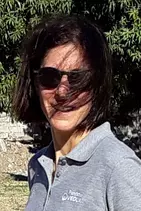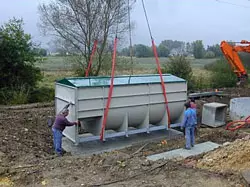Antonella Fioravanti, who has worked as an engineer for the Veolia group since 2001, has been a Veoliaforce volunteer for more than fifteen years. She has been involved in the project undertaken in Haiti with MSF since its inception.

When did you first hear about the project?
Antonella Fioravanti: Let me see, it was a very long time ago now, during an initial meeting at Médecins Sans Frontières (MSF) back in ... 2012! At the time, they were running three hospitals in Haiti and were already familiar with the principle of the biodisc, a solution they wanted to implement at the Drouillard district hospital in Port-au-Prince. Time went by, and the project remained on stand-by for some time before it was finally restarted and I arrived in 2017 for a ten-day mission. The first task was to measure the quantity of water to be treated and to characterize the pollution.

Did this first diagnostic mission lead to the designing of a treatment solution?
AF: Not immediately. There were a lot more unknowns than we had anticipated. In particular, it was impossible to visualize the flow cartography. Septic tanks had been dug all over the place, as new buildings being built to expand the hospital, and it was impossible to work out where the wastewater was coming from and going to. However, this is essential in order to be able to take relevant samples and correctly analyse what needs to be treated. So the mission took longer than expected. An MSF employee continued the analyses after my departure, which allowed us to start with reliable data.
So did you continue to follow the project remotely?
AF: Yes. I was lucky to be able to stay involved in this project from the beginning until the commissioning of the chosen solution.
Did you return in 2020?
AF: Yes, we had already remotely specified the biodisc dimensions and started the costing for the equipment required, but we had to compare our projections to the actual field conditions. The size of the biodisc can vary from single to double depending on the flow rate and capacity required. The hospital had changed over time, and the environment too. We modified the layout initially planned for the biodisc and we came back with a hydraulic profile and the list of equipment to order to install everything.
You have been involved in Veoliaforce missions in Madagascar, India, Zimbabwe and Cuba. Are there always surprises waiting for you when you arrive in the field?
AF: Yes, and there’s always an element of apprehension. You have to pay attention to everything, staying focused and not letting your attention stray. Although I have to manage, lead teams and pilot projects in my daily work at Veolia Water Technologies (VWT), I don’t take initiatives alone when I’m out in the field. We work hand in hand with our partner NGO during the mission and, back in the office, we often ask advice from colleagues who give up their own time to answer us. I turned to the VWT design office for the plans, then to a specialised engineer when it came to the pumps… A Veoliaforce mission is a collective adventure!


